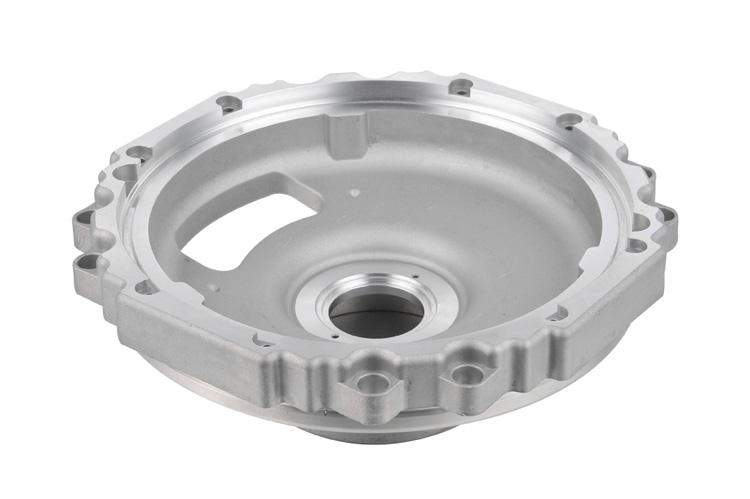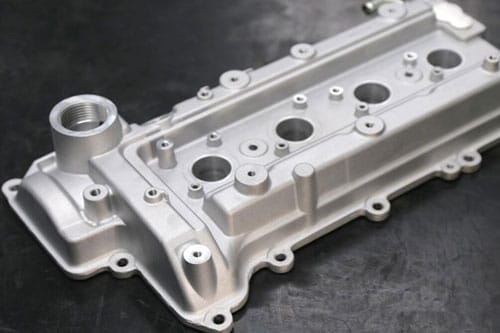Uncovering the Conveniences and Practical Utilizes of Aluminum Castings in Today's Market
Light weight aluminum castings have actually come to be increasingly pertinent in numerous sectors as a result of their one-of-a-kind characteristics. Their lightweight nature and resistance to rust make them appropriate for demanding applications. Additionally, the superior strength-to-weight proportion offers significant benefits in style and manufacturing. As industries continue to explore their possibility, the complete scope of light weight aluminum castings' benefits and applications continues to be to be fully discovered. What exists ahead for this functional material?
The Lightweight Benefit of Aluminum Castings
Many materials are used in manufacturing, aluminum spreadings stand out mainly due to their light-weight homes. This characteristic makes light weight aluminum spreadings an attractive selection for various markets, particularly in aerospace and auto applications, where weight decrease is vital for improving gas efficiency and efficiency. The lightweight nature of light weight aluminum allows producers to produce parts that are easier to handle and set up, eventually minimizing labor expenses.
The capability to create complex forms without significant weight penalties allows designers to introduce while preserving architectural honesty. Light weight aluminum castings can efficiently change heavier products, resulting in considerable financial savings in delivery and functional expenses. Their light-weight benefit likewise adds to enhanced item long life, as lighter parts often result in lowered wear and tear on machinery. In general, the light-weight buildings of light weight aluminum spreadings supply producers with an one-upmanship, promoting developments in item style and performance throughout different fields.

Extraordinary Corrosion Resistance
Light weight aluminum spreadings possess an all-natural resistance to oxidation, which greatly enhances their long life in various atmospheres. This integral residential property not only contributes to their longevity but additionally straightens with the lightweight benefit that light weight aluminum offers. Because of this, aluminum castings are progressively identified for their remarkable rust resistance in countless applications.

Naturally Immune to Oxidation
Among the standout characteristics of aluminum castings is their remarkable rust resistance, which comes from a natural oxidation procedure. When subjected to air, aluminum reacts to develop a slim, protective layer of light weight aluminum oxide. This layer functions as an obstacle versus additional oxidation and protects the underlying metal from destructive components such as moisture and salts. Unlike various other metals, this oxide layer is self-repairing; if damaged, it swiftly reforms when revealed to air. This one-of-a-kind home improves the longevity of light weight aluminum spreadings in various environments, making them excellent for applications in markets such as aerospace, automotive, and marine. Subsequently, the all-natural resistance to oxidation significantly decreases maintenance costs and raises the reliability of light weight aluminum castings popular problems.
Light-weight Resilience Benefit
The light-weight nature of light weight aluminum spreadings adds significantly to their toughness, making them a helpful option in various sectors. This extraordinary sturdiness is greatly connected to aluminum's inherent resistance to deterioration, which is boosted additionally via anodizing and various other surface therapies. Unlike many metals, aluminum does not rust; instead, it develops a protective oxide layer that guards it from ecological damages. This residential property is specifically useful in fields such as auto and aerospace, where weight reduction is essential without jeopardizing strength. Additionally, the long life of aluminum spreadings minimizes maintenance prices and replacements, providing economic advantages with time. Consequently, their lightweight sturdiness and deterioration resistance position light weight aluminum castings as a remarkable material for modern-day production applications.
Superior Strength-to-Weight Ratio
An impressive characteristic of aluminum castings is their superior strength-to-weight ratio, which makes them extremely desirable in different applications. This innate residential or commercial property permits aluminum spreadings to withstand significant stress while remaining lightweight, a crucial element in markets such as aerospace, automobile, and manufacturing. Designers typically like light weight aluminum spreadings for elements that need both longevity and reduced weight, enhancing fuel efficiency and efficiency.
The high strength-to-weight proportion likewise promotes the design of intricate forms and frameworks, making aluminum castings functional for facility applications. Moreover, the capability to maintain architectural stability under difficult conditions guarantees longevity and integrity in items, from aircraft frameworks to automotive parts. This benefit adds to the expanding trend of making use of aluminum spreadings in ingenious designs, inevitably causing improved performance and performance across varied industries. The exceptional strength-to-weight ratio of light weight aluminum castings places them as an essential material in contemporary design and manufacturing.
Cost-Effectiveness in Manufacturing
Cost-effectiveness in light weight aluminum casting manufacturing is primarily achieved with lowered product waste and reliable production processes. By maximizing designs and using innovative strategies, suppliers can reduce excess product usage while keeping high quality requirements. This strategy not only reduces manufacturing costs but likewise adds to extra lasting methods within the sector.
Reduced Material Waste
Lowering product waste go in light weight aluminum casting processes considerably boosts production effectiveness. By optimizing the design and production strategies, business can reduce excess scrap and improve resource use. This reduction in waste not just lowers material costs however likewise adds to a much more lasting manufacturing design. The ability to recycle aluminum further supports cost-effectiveness, permitting manufacturers to recover and recycle materials without endangering top quality. As the market significantly concentrates on sustainability, reduced material waste straightens with ecological objectives while concurrently increasing earnings. Eventually, efficient usage of resources enhances the affordable placement of organizations in the marketplace, making light weight aluminum castings a favorable alternative in different applications. The tactical approach to decreasing waste mirrors a commitment to both economic and environmental obligation.
Efficient Production Processes
While standard manufacturing procedures can incur substantial expenses, aluminum spreading provides a more reliable option that enhances general production earnings. This approach decreases material waste and permits for accurate control over the manufacturing process, bring about reduced labor and functional costs. The capacity to produce intricate shapes with less steps even more simplifies manufacturing, adding to shorter preparations. In addition, light weight aluminum's light-weight nature and superb thermal conductivity permit energy savings throughout manufacturing and in the final application. By using modern-day spreading innovations, manufacturers can accomplish greater throughput without sacrificing high quality. Aluminum spreading stands out as a cost-effective option, making it an appealing choice for organizations aiming to optimize their production processes in today's affordable market.
Versatility Across Industries
Light weight aluminum spreadings show impressive versatility across different sectors, as they can be customized to fulfill details needs and applications. In the automotive industry, light weight aluminum castings are utilized in engine blocks, transmission housings, and wheels, providing lightweight yet resilient services that improve fuel effectiveness. The aerospace market also benefits from aluminum castings, using them in architectural elements and engine parts as a result of their strength-to-weight ratio.
In the durable goods industry, makers utilize aluminum castings for products varying from cooking equipment to furnishings, supplying both aesthetic appeal and capability. The electronic devices market makes use of light weight aluminum castings for housings and warm sinks, making certain effective thermal monitoring. Furthermore, the building industry leverages aluminum castings for architectural elements and architectural components, boosting longevity and style flexibility. This wide applicability highlights aluminum spreadings as an essential source, satisfying the varied requirements of various markets while keeping high efficiency and reliability.
Sustainability and Environmental Influence
As sectors progressively prioritize sustainable practices, aluminum spreadings become a green option view it now because of their recyclability and low ecological footprint. Light weight aluminum is one of the most recycled products worldwide, with the capacity to be repurposed several times without destruction of quality. This particular greatly lowers the demand for raw products and energy usage linked with primary aluminum manufacturing, which is energy-intensive.
In addition, aluminum castings add to lightweight styles, resulting in sustain efficiency in transportation applications such as auto and aerospace markets. Their durability and resistance to deterioration expand product life expectancies, additionally minimizing waste and resource use with time. Many manufacturers are taking on accountable sourcing and eco pleasant manufacturing techniques, enhancing the sustainability of light weight aluminum spreading processes. On the whole, aluminum castings represent a sensible service for organizations intending to reduce their ecological influence while attaining efficiency and performance.
Developments in Aluminum Casting Technologies
Recent innovations in light weight aluminum spreading innovations have greatly boosted the effectiveness and high quality of manufacturing processes. Innovations such as 3D printing and progressed mold-making techniques have actually allowed suppliers to develop complex designs with lowered product waste. This shift not only boosts the precision of actors elements but additionally reduces lead times, permitting fast prototyping and faster market entry.
In addition, the consolidation of sophisticated computer system simulations aids in forecasting prospective issues during spreading, resulting in higher-quality results (Aluminum Foundry). Making use of light-weight alloys has likewise added to the advancement of more powerful, more long lasting items, dealing with markets varying from automobile to aerospace
In addition, automated casting processes have actually arised, minimizing human error and boosting manufacturing speed. Collectively, these advancements are changing the aluminum casting landscape, driving greater competition and sustainability in production. As markets continue to evolve, these modern technologies will play a vital role in conference future demands for efficiency and high quality.
Frequently Asked Concerns
Exactly How Do Light Weight Aluminum Castings Compare to Various Other Steels in Regards To Thermal Conductivity?
Light weight aluminum spreadings display superior thermal conductivity compared to many metals, such as steel and iron - Metal Castings. Their light-weight nature and effective warm circulation make them excellent for applications calling for efficient thermal administration in different markets
What Are the Usual Flaws Located in Light Weight Aluminum Castings?
Common problems in light weight aluminum castings include porosity, shrinkage, inclusions, and surface abnormalities. These concerns usually arise from improper air conditioning prices, poor mold design, or contaminations, impacting the overall quality and efficiency of the last item.
Can Aluminum Castings Be Recycled, and How?
Light weight aluminum castings can be reused efficiently. The procedure includes gathering, melting, and reforming the light weight aluminum, which decreases waste and saves resources. This reusing adds helpful site to sustainability while preserving the material's residential or commercial properties for future usage.
What Are the Regular Lead Times for Aluminum Casting Manufacturing?
Usually, lead times for light weight aluminum casting manufacturing variety from two to six weeks, depending on variables such as complexity, tooling needs, and manufacturing volume. Performance can improve with established vendor relationships and maximized production procedures.
Just how Does the Surface Area Complete Affect Aluminum Spreading Efficiency?
The surface finish significantly affects aluminum casting efficiency by influencing rust resistance, aesthetic top quality, and friction features. A smoother surface boosts sturdiness and functionality, while a rougher structure can enhance adhesion for subsequent coatings or treatments.
Several materials are utilized in production, aluminum castings stand out mostly due to their light-weight residential properties. When revealed to air, aluminum responds to form a thin, safety layer of aluminum oxide. Cost-effectiveness in aluminum spreading production is primarily accomplished with lowered material waste and effective manufacturing procedures. Minimizing material waste in aluminum casting processes considerably boosts manufacturing performance. Ultimately, effective use of raw products enhances the affordable placement of organizations in the market, making aluminum castings a beneficial choice in different applications.